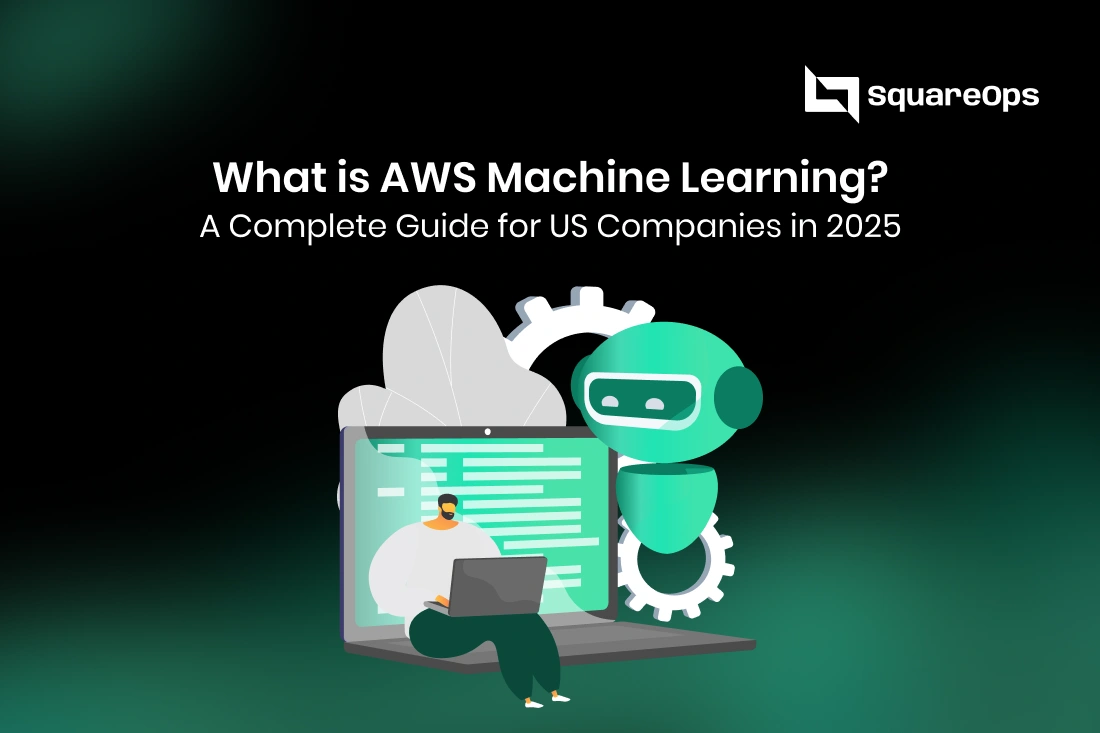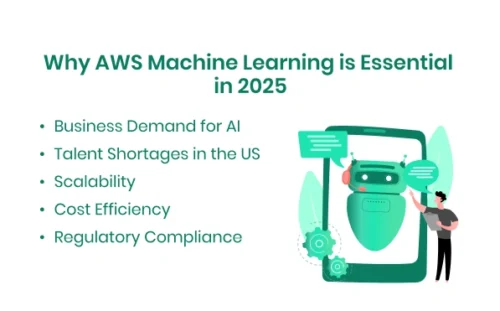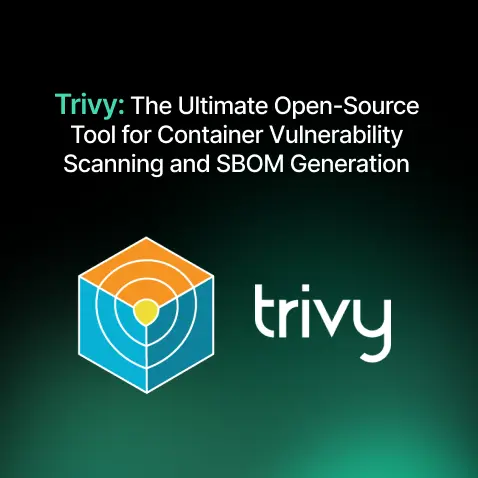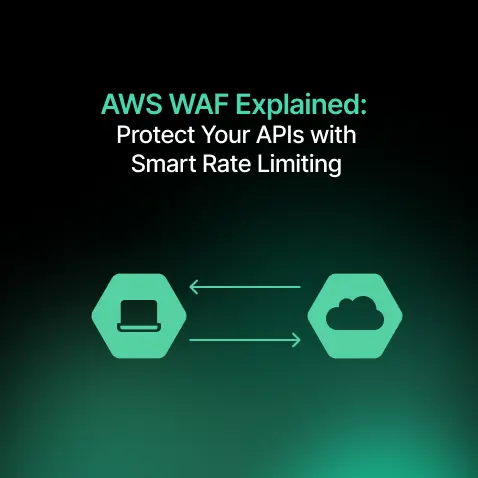What is AWS Machine Learning? A Complete Guide for US Companies in 2025
- Nitin Yadav
- Knowledge
About

AWS Machine Learning empowers US companies to build, train, and deploy AI models faster using SageMaker, Rekognition, and more driving scalable, secure innovation in 2025.
Industries
- AI and Machine Learning in USA, Amazon SageMaker, AWS AI services, AWS cloud AI solutions, AWS Comprehend, AWS DevOps and MLOps, AWS Forecast, AWS Fraud Detector, AWS Machine Learning, AWS ML, AWS ML for enterprises, AWS ML for US companies, AWS ML guide 2025, AWS ML pricing, AWS ML use cases, AWS Personalize, AWS Rekognition, AWS Textract, Machine Learning on AWS, SquareOps AWS Machine Learning
Share Via
Artificial Intelligence (AI) and Machine Learning (ML) have shifted from futuristic buzzwords to core business drivers in the US. SaaS platforms use ML for personalization, FinTech firms use it for fraud detection, healthcare organizations rely on it for diagnostics, and retailers deploy it to forecast demand. By 2025, the US market for AI-powered solutions is valued in the hundreds of billions and AWS is leading the charge.
But here’s the challenge: building and scaling machine learning infrastructure from scratch is costly and complex. Hiring data scientists, managing clusters, tuning models, and ensuring compliance can overwhelm even large enterprises. That’s where AWS Machine Learning comes in.
AWS offers a robust ecosystem of ML services, tools, and frameworks that make it possible for businesses of all sizes from startups to Fortune 500s to integrate machine learning into their workflows. Whether you’re training custom models or leveraging pre-trained services like Rekognition (image analysis) or Comprehend (NLP), AWS ML provides flexibility, scalability, and cost-efficiency.
This guide explores everything US companies need to know in 2025: what AWS ML is, its services, benefits, pricing, real-world use cases, and how to get started.
What is AWS Machine Learning?
AWS Machine Learning (AWS ML) refers to the suite of cloud-based tools and services provided by Amazon Web Services to build, train, deploy, and manage ML models at scale.
Instead of requiring massive infrastructure investments and complex engineering, AWS ML provides managed services that automate much of the machine learning lifecycle.
Key aspects:
- Accessibility: Democratizes ML for businesses without large AI teams.
- Scalability: Supports workloads ranging from small experiments to enterprise-scale pipelines.
- Integration: Works seamlessly with AWS storage (S3), compute (EC2, Lambda), and analytics (Redshift, QuickSight).
- Security: Designed for compliance-heavy industries (HIPAA, SOC2, PCI DSS).
AWS first introduced Amazon Machine Learning in 2015. Since then, it has expanded into a full ecosystem, anchored by Amazon SageMaker (end-to-end ML platform) and supplemented by numerous pre-built AI services.
Put simply: AWS ML is the fastest way for US companies to put AI into production.
Core AWS Machine Learning Services
AWS ML is divided into two broad categories:
a) Foundational ML Platform
Amazon SageMaker
- End-to-end service for building, training, and deploying models.
- Includes AutoML, hyperparameter tuning, and model monitoring.
- Supports MLOps with pipelines and model registries.
- Example: A SaaS company uses SageMaker to predict customer churn.
b) Pre-Built AI/ML Services
AWS also offers ready-to-use AI services, requiring no ML expertise:
- Rekognition – Image & video analysis (facial recognition, object detection).
- Comprehend – Natural Language Processing (NLP) for sentiment analysis, entity recognition.
- Textract – Automatically extracts text and data from documents.
- Translate – Neural machine translation.
- Lex – Conversational AI for chatbots (same tech behind Alexa).
- Polly – Text-to-speech service.
- Forecast – Time-series forecasting for demand planning.
- Personalize – Recommendation engine (like Amazon.com’s product suggestions).
- Fraud Detector – Detects potentially fraudulent activities in real time.
These services allow US businesses to embed powerful AI capabilities without needing dedicated ML teams.
Why AWS Machine Learning is Essential in 2025

- Business Demand for AI
- From fraud detection to personalization, AI is no longer optional.
- Competitors who leverage ML gain faster decision-making and improved customer experience.
- Talent Shortages in the US
- Data scientists and ML engineers command salaries above $150k/year.
- AWS ML reduces dependency on specialized in-house teams.
- Scalability
- Startups can experiment cheaply, while enterprises scale to millions of transactions daily.
- Startups can experiment cheaply, while enterprises scale to millions of transactions daily.
- Cost Efficiency
- Pay-as-you-go pricing means no upfront infrastructure investment.
- Pay-as-you-go pricing means no upfront infrastructure investment.
- Regulatory Compliance
- HIPAA, SOC2, and PCI DSS-ready services make AWS ML adoption safer for regulated industries.
For US businesses in 2025, AWS ML is not just about efficiency, it’s about staying competitive in an AI-driven market.
How AWS Machine Learning Works
AWS ML follows a standard lifecycle, simplified with managed services:
- Data Collection
- Sources: AWS S3, IoT Core, Kinesis (real-time), RDS/Redshift (databases).
- Sources: AWS S3, IoT Core, Kinesis (real-time), RDS/Redshift (databases).
- Data Preparation
- AWS Glue and SageMaker Data Wrangler clean, normalize, and label datasets.
- AWS Glue and SageMaker Data Wrangler clean, normalize, and label datasets.
- Model Training
- Use SageMaker with built-in algorithms or custom frameworks (TensorFlow, PyTorch, MXNet).
- AutoML options for non-experts.
- Model Deployment
- Deploy to SageMaker endpoints, integrate with Lambda, or embed into apps.
- Deploy to SageMaker endpoints, integrate with Lambda, or embed into apps.
- Monitoring & Optimization
- SageMaker Model Monitor detects drift.
- CloudWatch tracks performance and costs.
Example Workflow:
A retail company stores historical sales data in S3 → preps data with Glue → trains a forecasting model in SageMaker → deploys to a live endpoint → uses QuickSight dashboards for business teams.
AWS Machine Learning Use Cases for US Companies
- SaaS Platforms
- Predicting churn, personalizing user experiences, automating support via Lex chatbots.
- Predicting churn, personalizing user experiences, automating support via Lex chatbots.
- FinTech
- Real-time fraud detection with Fraud Detector.
- Credit risk scoring with SageMaker models.
- Healthcare
- HIPAA-compliant diagnostic support.
- Patient monitoring with IoT + ML pipelines.
- Retail & E-commerce
- Demand forecasting with Forecast.
- Personalized product recommendations with Personalize.
- Manufacturing/IoT
- Predictive maintenance with sensor data.
- Quality control using Rekognition for image inspection.
- Media & Entertainment
- Video analytics for audience engagement.
- Content personalization using Comprehend + Personalize.
These use cases show how AWS ML enables industry-specific solutions for US companies.
Benefits of Using AWS Machine Learning
- Faster Innovation – Experiment and deploy ML models in weeks, not years.
- Scalability – Handle millions of users and transactions.
- Pre-Trained Models – Save cost and complexity.
- Seamless Integration – Works with AWS storage, compute, and analytics.
- Accessibility – Democratizes ML for both developers and business users.
- Security & Compliance – Meets strict US regulatory needs.
AWS Machine Learning Pricing Explained
- SageMaker
- Pay for training, endpoint hosting, and data processing.
- Example: $0.10/hour for training on smaller instances → scales to larger clusters.
- Pre-Built Services
- Rekognition: per image/video minute.
- Polly: per million characters.
- Translate: per million characters translated.
- Forecast/Personalize: based on data points processed.
- Cost Optimization Strategies:
- Use spot instances for cheaper training.
- Optimize models with AutoML.
- Monitor usage with CloudWatch to avoid bill shock.
AWS Machine Learning vs Competitors
Feature | AWS ML | Google Cloud AI | Azure AI |
Breadth of Services | Largest ML service portfolio | Research-driven, TensorFlow | Strong enterprise focus |
Ease of Use | AutoML, pre-built APIs | Requires expertise in ML tools | Easy integration w/ MS tools |
Ecosystem | Deep AWS integration | Strong open-source ecosystem | Microsoft Office + Dynamics |
Compliance | HIPAA, SOC2, PCI DSS ready | Weaker compliance focus | Strong enterprise compliance |
Best Fit | US SaaS, FinTech, healthcare | Research & AI-first startups | Enterprises w/ MS stack |
AWS stands out for its breadth of services and enterprise compliance, making it ideal for US companies.
Getting Started with AWS Machine Learning (Tutorial)
- Create AWS Account & IAM Roles
- Set permissions for ML users.
- Set permissions for ML users.
- Prepare Data in S3
- Upload structured/unstructured data.
- Upload structured/unstructured data.
- Open SageMaker
- Choose “AutoML” or custom model training.
- Choose “AutoML” or custom model training.
- Train Model
- Select algorithm, configure computer, run training job.
- Select algorithm, configure computer, run training job.
- Deploy Endpoint
- Deploy model for real-time predictions.
- Deploy model for real-time predictions.
- Monitor Results
- Use CloudWatch and SageMaker Monitor.
Even non-technical business teams can build models using AutoML interfaces.
Best Practices for AWS Machine Learning
- Ensure Data Quality – Poor input = poor output.
- Automate Pipelines – Use SageMaker Pipelines for CI/CD in ML.
- Optimize Models – Use hyperparameter tuning.
- Secure Access – Apply IAM restrictions and encrypt data.
- Manage Costs – Use spot instances, right-size resources.
Future of AWS Machine Learning
- Generative AI Expansion – AWS investing in LLMs and foundation models.
- AI + IoT Convergence – Real-time analytics at the edge.
- Autonomous ML Pipelines – Fully automated MLOps workflows.
- Democratization of AI – Business teams deploying models without coding.
- 2030 Outlook – AI-first companies dominating US markets.
Conclusion
AWS Machine Learning has become the go-to platform for US companies in 2025. From scalable infrastructure to ready-to-use AI services, AWS makes it possible for businesses of all sizes to adopt ML cost-effectively and securely.
Whether you’re a SaaS startup predicting churn, a FinTech fighting fraud, or a healthcare provider managing HIPAA data, AWS ML provides tools tailored to your industry.
To accelerate adoption, US companies can partner with SquareOps, experts in AWS ML integration. We help SaaS and enterprises design, deploy, and optimize ML pipelines that deliver measurable business outcomes.
Frequently asked questions
AWS Machine Learning is Amazon’s suite of services for building, training, and deploying ML models in the cloud.
SageMaker, Rekognition, Comprehend, Textract, Translate, Lex, Polly, Forecast, Personalize, Fraud Detector
Fraud detection, personalization, diagnostics, demand forecasting, video analytics, predictive maintenance.
Pay-as-you-go model, charged by training hours, data processed, or API usage.
AWS offers the broadest service portfolio and stronger compliance, while Google leads in research and Azure integrates tightly with Microsoft’s enterprise stack.
Yes. AWS ML offers pay-as-you-go pricing, allowing startups and SMBs to experiment, deploy AI solutions, and scale affordably without heavy upfront costs.
Amazon SageMaker automates the full ML lifecycle data prep, training, tuning, and deployment helping teams build accurate models quickly without deep ML expertise.
Absolutely. AWS ML integrates seamlessly with AWS S3, Redshift, RDS, and external APIs to unify data pipelines and enable real-time predictive analytics.
AWS ML is built for compliance with HIPAA, SOC2, PCI DSS, and GDPR, ensuring that regulated US industries can adopt AI while meeting strict data-security standards.
SquareOps specializes in AWS ML integration designing pipelines, managing SageMaker deployments, and optimizing performance for measurable AI business outcomes.
Related Posts

Comprehensive Guide to HTTP Errors in DevOps: Causes, Scenarios, and Troubleshooting Steps
- Blog

Trivy: The Ultimate Open-Source Tool for Container Vulnerability Scanning and SBOM Generation
- Blog

Prometheus and Grafana Explained: Monitoring and Visualizing Kubernetes Metrics Like a Pro
- Blog

CI/CD Pipeline Failures Explained: Key Debugging Techniques to Resolve Build and Deployment Issues
- Blog

DevSecOps in Action: A Complete Guide to Secure CI/CD Workflows
- Blog

AWS WAF Explained: Protect Your APIs with Smart Rate Limiting
- Blog

